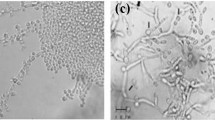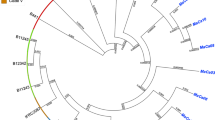Abstract
Purpose of Review
This review summarizes the analysis of the internal transcribed spacers (ITS) sequencing of Coccidioides spp. strains isolated in the endemic region of coccidioidomycosis in Argentina, to be able to associate the presence of a specific fungal genotype with a specific geographical region.
Recent Findings
Recent studies have focused on the identification and genetic variability between and intraspecies as a tool to contribute to the coccidioidomycosis epidemiology; these findings may contribute to the specific identification of circulating strains of Coccidioides spp. in Argentina.
Summary
Coccidioides immitis and C. posadasii are causative agents of coccidioidomycosis, an endemic mycosis of arid and semiarid regions of America. The classic diagnosis based on microbiological methods only identifies up to the level of gender, being sufficient to initiate a treatment, since until now no specific clinical differences associated with one or another species have been described. It is likely that the number of strains analyzed here only represents a small portion of the circulating strains in our region; however, the ITSs sequencing from strains isolated in the Argentine territory has allowed us to conclude that the strains circulating in our country to date are C. posadasii.

Similar content being viewed by others
References
Papers of particular interest, published recently, have been highlighted as: • Of importance •• Of major importance
Fisher MC, Koenig GL, White TJ, Taylor JW. Molecular and phenotypic description of Coccidioides posadasii sp. nov., previously recognized as the non-California populations of Coccidioides immitis. Mycologia. 2002;94(1):73–84.
Posadas A. Un Nuevo caso de micosis fungoide con psorospermias. Círculo Médico Argentino. 1892;52:1–11.
Rixford E, Gilchrist TC. Two cases of protozoan (coccidioidal) infection of the skin and other organs. Jhon’s Hopkins Hosp Rep. 1896;1:209–68.
Ophüls W, Moffitt HC. A new pathogenic mould (formerly described as a protozoon: Coccidioides immitis pyogenes). Phil Med J. 1900;5:1471–2.
Egeberg RO, Elconin AE, Egeberg MC. Effect of salinity and temperature on Coccidioides immitis and three antagonistic soil saprophytes. J Bacteriol. 1964;88(2):473–6.
Elconin AF, Egeberg RO, Egeberg MC. Significance of soil salinity on the ecology of Coccidioides immitis. J Bacteriol. 1964;87(3):500–3.
• Stockamp NW, Thompson GR. Coccidioidomycosis. Infect Dis Clin N Am. 2016;30(1):229–46 This article is a review about epidemiology, clinical manifestations, risk factors and treatment of Coccidioidomycosis.
Baptista-Rosas RC, Riquelme M. Epidemiología de la coccidioidomicosis en México. Rev Iberoam Micol. 2007;24(2):100–5.
Martínez-Méndez D, Semprún-Hernández N, Hernández-Valles R. Coccidioidomicosis: Estado actual de la endemia en Venezuela. Invest Clín. 2015;56(4):411–20.
• Giacomazzi J, Baethgen L, Carneiro LC, Millington MA, Denning DW, Colombo AL, et al. The burden of serious human fungal infections in Brazil. Mycoses. 2016;59(3):145–50 In Brazil, as in other countries, mycoses are not subject to mandatory reporting. In this paper, the authors carry out a study on the incidence of cases of severe mycoses, including coccidioidomycosis.
Negroni R. Evolución de los conocimientos sobre aspectos clínico-epidemiológicos de la Coccidioidomycosis en las Américas. Rev Arg Microbiol. 2008;40:246–56.
Canteros CE, Toranzo A, Ibarra-Camou B, David V, Carrizo SG, Santillán-Iturres A, et al. La coccidioidomicosis en Argentina: 1892-2009. Rev Arg Microbiol. 2010;42(4):261–8.
Bialek R, Kern J, Herrmann T, Tijerina R, Ceceñas L, Reischl U, et al. PCR assays for identification of Coccidioides posadasii based on the nucleotide sequence of the antigen 2/proline-rich antigen. J Clin Microbiol. 2004;42(2):778–83.
de Aguiar CR, Nogueira Brilhante RS, Gadelha Rocha MF, Araújo Moura FE. Pires de Camargo Z, Costa Sidrim JJ. Rapid diagnosis of coccidioidomycosis by nested PCR assay of sputum. Clin Microbiol Infect. 2007;13(4):449–51.
Johnson SM, Simmons KA, Pappagianis D. Amplification of coccidioidal DNA in clinical specimens by PCR. J Clin Microbiol. 2004;42(5):1982–5.
Binnicker MJ, Buckwalter SP, Eisberner JJ, Stewart RA, McCullough AE, Wohlfiel SL, et al. Detection of Coccidioides species in clinical specimens by real-time PCR. J Clin Microbiol. 2007;45(1):173–8.
Vucicevic D, Blair JE, Binnicker MJ, McCullough A, Kusne S, Vikram HR, et al. The utility of Coccidioides polymerase chain reaction testing in the clinical setting. Mycopathologia. 2010;170(5):345–51.
Gago S, Buitrago MJ, Clemons KV, Cuenca-Estrella M, Mirels LF, Stevens DA. Development and validation of a quantitative real-time PCR assay for the early diagnosis of coccidioidomycosis. Diag Microbiol Infect Dis. 2014;79(2):214–21.
Tintelnot K, De Hoog GS, Antweiler E, et al. Taxonomic and diagnostic markers for identification of Coccidioides immitis and Coccidioides posadasii. Med Mycol. 2007;45(5):385–93.
Brilhante RSN, de Lima RAC, Ribeiro JF, de Camargo ZP, Castelo-Branco DDSCM, Grangeiro TB, et al. Genetic diversity of Coccidioides posadasii from Brazil. Med Mycol. 2013;51(4):432–7.
Luna-Isaac JA, Muñiz-Salazar R, Baptista-Rosas RC, et al. Genetic analysis of the endemic fungal pathogens Coccidioides posadasii and Coccidioides immitis in México. Med Mycol. 2015;52(2):156–66.
•• Engelthaler DM, Roe CC, Hepp CM, et al. Local population structure and patterns of western hemisphere dispersal for Coccidioides spp., the fungal cause of Valley Fever. MBio. 2016;7(2):1–15 In this work the authors demonstrated the presence of different geographical clades mainly ofC. posadasiiin the endemic regions. Molecular and phylogenetic analyzes indicated thatC. posadasiiis the oldest of the two species with a proposed origin in southern Arizona and northern Mexico, from where it would have dispersed to other regions.
White TJ, Bruns T, Lee S, Taylor J. Amplification and direct sequencing of fungal ribosomal RNA gene for phylogenetics. In: Innis MA, Gelfand DH, Sninsky JJ, White TJ, editors. PCR protocols: a guide to methods and applications. San Diego, CA: Academic Press; 1990. p. 315–22.
Johnson SM, Carlson EL, Pappagianis D. Coccidioides species determination: does sequence analysis agree with restriction fragment length polymorphism? Mycopathol. 2015;179(5–6):373–9.
Altschul SF, Gish W, Miller W, Myers EW, Lipman DJ. Basic local alignment search tool. J Mol Biol. 1990;215(3):403–10.
Hall TA. BioEdit: a user-friendly biological sequence alignment editor and analysis program for windows 95/98/NT. NASS. 1999;41:95–8.
Tamura K, Stecher G, Peterson D, Filipski A, Kumar S. MEGA6: molecular evolutionary genetics analysis version 6.0. Mol Biol Evol. 2013;30(12):2725–9.
Kimura M. A simple method for estimating evolutionary rate of base substitutions through comparative studies of nucleotide sequences. J Mol Evol. 1980;16:111–20.
•• Laniado-Laborín R, Arathoon EG, Canteros C, Muñiz-Salazar R, Rendon A. Coccidioidomycosis in Latin America. Med Mycol. 2019;57:S46–55. https://doi.org/10.1093/mmy/myy037This review presents the current state of coccidiodomycosis in Latin America and the difficulties in its early diagnosis in endemic regions.
Galgiani JN, Ampel NM, Blair JE, Catanzaro A, Johnson RH, Stevens DA, et al. Infectious Diseases Society of America. Clin Infect Dis. 2005;41(9):1217–23. https://doi.org/10.1086/496991.
Ampel NM. The diagnosis of coccidioidomycosis. F1000 Med Rep. 2010;2:2. 103410/M2-2.
Brown J, Benedict K, Park BJ, Thompson GR III. Coccidioidomycosis: epidemiology. Clin Epidemiol. 2013;5:185–97.
Canteros CE, Vélez HA, Toranzo AI, et al. Molecular identification of Coccidioides immitis in formalin-fixed, paraffin-embedded (FFPE) tissues from a Colombian patient. Med Mycol. 2015;53:520–7.
Schoch CL, Seifert KA, Huhndorf S, Robert V, Spouge JL, Levesque CA, et al. Nuclear ribosomal internal transcribed spacer (ITS) region as a universal DNA barcode marker for Fungi. PNAS. 2012;109(16):6241–6. https://doi.org/10.1073/pnas.1117018109.
•• Teixeira MM, Barker BM. Use of population genetics to assess the ecology, evolution, and population structure of Coccidioides. Emerg infect dis. 2016;22(6):1022–30. https://doi.org/10.3201/eid2206.151565This paper described the different subpopulations of eachCoccidioidesspecies, from both human and environmental isolates. Phylogenetic and ecological studies are important in determining the distribution of each genotype and its possible association with virulence and disease progression.
Author information
Authors and Affiliations
Corresponding author
Ethics declarations
Conflict of Interest
Andrea Nora Motter, María Cecilia López-Joffre, Adriana Toranzo, Damián Salas, Mariana Viale, Flavia Vivot, Alejandra Hevia, Ruben Abrantes, Julián Fernández, Cristina Canteros, and Roberto Suárez-Alvarez declare no conflicts of interest relevant to this manuscript.
Human and Animal Rights and Informed Consent
This article does not contain any studies with human or animal subjects performed by any of the authors.
Additional information
Publisher’s Note
Springer Nature remains neutral with regard to jurisdictional claims in published maps and institutional affiliations.
This article is part of Topical Collection on Clinical Mycology Lab Issues
Rights and permissions
About this article
Cite this article
Motter, A.N., López-Joffre, M.C., Toranzo, A. et al. Molecular Characterization of Coccidioides spp. Strains Isolated from Patients in the Argentine Republic. Curr Fungal Infect Rep 14, 15–20 (2020). https://doi.org/10.1007/s12281-020-00372-9
Published:
Issue Date:
DOI: https://doi.org/10.1007/s12281-020-00372-9




